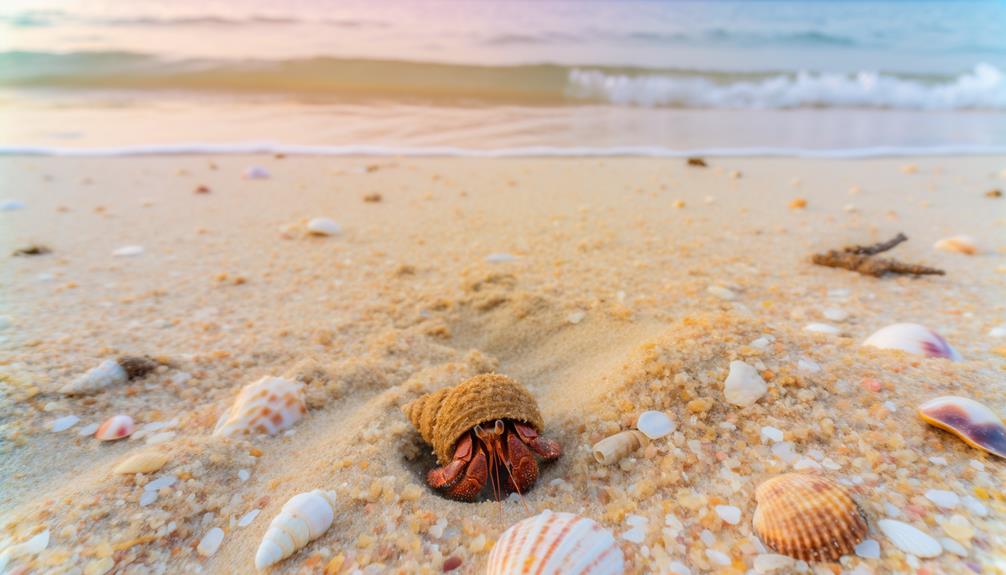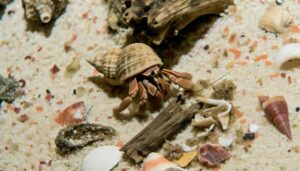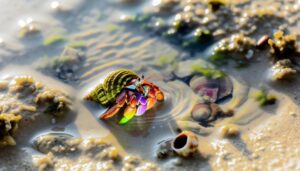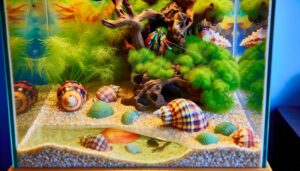Do Hermit Crabs Carry Diseases?
Hermit crabs don't bury themselves to die. They typically burrow to molt, which involves shedding their exoskeleton and growing a new one.
This process requires a safe, humid environment as they're extremely vulnerable at this time. Additionally, burrowing helps them regulate moisture and manage stress.
Creating deep, moist substrate is vital for their health. Monitoring their behavior and maintaining proper habitat conditions promote their well-being and longevity.
Proper understanding of their needs will provide further insights into ensuring their overall health and happiness.

Key Takeaways
- Hermit crabs primarily bury themselves for molting, not to die.
- Burying helps hermit crabs manage stress and regulate temperature.
- Proper humidity levels are crucial for a successful molting process.
- Burrowing provides a safe environment during vulnerable molting periods.
- Addressing stress and proper habitat care prevent unnecessary burying behavior.
Common Misconceptions
Despite popular belief, hermit crabs don't bury themselves solely to hide from predators. You might think they're just trying to stay safe, but there's more to it.
Hermit crabs often bury themselves when they're molting. Molting is an essential process where they shed their exoskeleton and grow a new, larger one. This makes them vulnerable, so they dig into the substrate for protection.
Additionally, burying helps them regulate moisture, which is crucial for their health. Without proper humidity, they can't successfully molt or breathe properly.
It's important to understand these behaviors if you're caring for hermit crabs. By providing the right environment, you're ensuring they can perform these essential activities safely and effectively.
Understanding Hermit Crab Behavior
Understanding hermit crab behavior involves recognizing their natural instincts and needs, which go beyond just molting and hiding. You'll notice that hermit crabs are social creatures, often forming clusters for protection and interaction.
They're also avid explorers, using their sensory antennae to navigate their surroundings and find food. It's pivotal to provide an environment that mimics their natural habitat, including varied terrain and humidity levels.
Hermit crabs communicate through chirping sounds and body movements, indicating their well-being and social status. Observing these behaviors helps you meet their needs more effectively, ensuring they thrive.
Natural Burrowing Instincts
Hermit crabs have a natural burrowing instinct that plays a vital role in their survival and well-being. When you observe these fascinating creatures, you'll notice they dig into the substrate frequently. This behavior isn't random; it's important for their stress management and temperature regulation.
By burrowing, hermit crabs create a stable microenvironment, protecting themselves from predators and harsh weather conditions. Additionally, burrows serve as safe havens during vulnerable periods, such as when they're resting or seeking solitude.
Understanding this instinct can help you provide better care for your hermit crabs. Make sure their habitat includes deep, moist substrate to support their natural burrowing needs and to promote their overall health and happiness.
Molting Process
During the molting process, hermit crabs shed their exoskeleton to grow and regenerate lost limbs. You'll notice that they burrow into the substrate to create a safe, humid environment important for the delicate phase.
Molting is a vulnerable time; the new exoskeleton is soft and susceptible to damage. This process can take several weeks, during which the crab is mostly immobile. By burrowing, they avoid predators and reduce stress, essential for a successful molt.
You should ensure the substrate is deep enough for this behavior and maintain best humidity levels. Understanding this helps you support your hermit crab's health and longevity, as molting is a regular and necessary part of their life cycle.
Stress and Burying
Observing your hermit crab's behavior, you'll notice that stress often triggers their instinct to bury themselves in the substrate. Stress can arise from various sources, such as changes in their environment, handling, or the presence of other crabs.
When hermit crabs feel threatened or uncomfortable, they instinctively seek refuge underground, mimicking their natural habitat's protective features. Burying themselves helps them feel safe and reduces their anxiety levels, allowing them to cope better with stressors.
As a caretaker, it's important to monitor their behavior closely and identify potential stress triggers. Addressing these issues promptly guarantees your hermit crab's well-being and prevents prolonged stress, which can lead to health complications.
Your attention to their needs makes a significant impact on their happiness and longevity.
Environmental Factors
A well-kept environment is crucial for preventing your hermit crab from feeling the urge to bury itself due to discomfort. Make sure your crab's habitat mimics its natural surroundings. Maintain optimal humidity levels between 70-80%, as low humidity can cause respiratory issues. Use a hygrometer to monitor this.
Temperature should be stable, ideally between 75-85°F. Provide a variety of substrates like sand and coconut fiber to allow natural burrowing behavior. Clean the habitat regularly to avoid mold and bacteria buildup, which can lead to stress.
Offer hiding spots and climbing structures to keep your hermit crab active and engaged. By creating a comfortable environment, you'll lessen the likelihood of your hermit crab burying itself out of distress.
Health Issues
Health issues in hermit crabs can often be indicated by changes in behavior, such as excessive burying. When you notice your crab burying itself more than usual, it could be a sign of underlying health problems. Keep an eye on other symptoms, as early detection is essential for proper care. Below is a table outlining common health issues and their indicators:
| Health Issue | Indicator |
|---|---|
| Dehydration | Lethargy, dry exoskeleton |
| Shell Rot | Foul odor, discolored shell |
| Mite Infestation | Visible mites, constant scratching |
| Stress | Erratic behavior, prolonged hiding |
| Nutritional Deficiency | Weakness, slow movement |
Predatory Protection
Hermit crabs often bury themselves to evade predators and secure their survival in a hostile environment. By burrowing into the sand, they create a physical barrier that makes it harder for predators to reach them. You'll find that this behavior is instinctual and important for their protection, especially since their shells alone don't offer complete safety.
When you observe a hermit crab burying itself, it's actively engaging in a survival strategy. This behavior also helps reduce stress, which is crucial for their well-being. By understanding and facilitating this natural instinct, you can better guarantee the safety and longevity of your hermit crabs.
Therefore, providing the right substrate depth is essential for their natural defensive behaviors.
Temperature Regulation
Beyond protection from predators, burying themselves also aids hermit crabs in regulating their body temperature. Hermit crabs are cold-blooded creatures, meaning their body temperature varies with the environment. By burrowing into the sand, they can avoid extreme temperature fluctuations, ensuring their survival and well-being.
Here's a table showcasing how different conditions impact hermit crabs:
| Condition | Above Ground Effect | Below Ground Effect |
|---|---|---|
| Hot Temperatures | Risk of overheating | Maintains cooler, stable temps |
| Cold Temperatures | Risk of hypothermia | Retains warmth |
| High Humidity | Potential respiratory issues | Balanced humidity levels |
| Low Humidity | Dehydration risk | Moist, favorable microclimate |
| Direct Sunlight | UV exposure, thermal stress | Shaded, controlled environment |
This behavior showcases their adaptability and instinct for self-preservation.
Safe Burrowing Practices
When setting up a habitat for your hermit crab, make certain the substrate is deep enough to allow them to burrow safely and comfortably. Aim for at least six inches of a mix of sand and coconut fiber. This combination provides stability and moisture retention, essential for a healthy burrowing environment.
Check the substrate regularly to make certain it's not too dry or too wet, as extremes can harm your crab. Additionally, maintain a temperature range of 75-85°F to mimic their natural habitat. By providing these conditions, you support natural behaviors essential for their well-being.
Proper burrowing practices not only offer physical security but also reduce stress, promoting a longer, healthier life for your hermit crab.
Monitoring Your Hermit Crab
To guarantee your hermit crab's well-being, it's essential to recognize normal behavior, identify signs of stress, and follow proper care tips.
Regularly observe your crab's activity to distinguish between healthy burrowing and potential issues. By staying vigilant, you can provide a safe, nurturing environment for your pet.
Identifying Normal Behavior
Observing your hermit crab's daily activities helps establish a baseline for its normal behavior. Take note of its eating habits, typical movement patterns, and interactions with its environment.
Healthy hermit crabs are generally active, exploring their habitat, climbing, and burrowing. They often change shells and exhibit curiosity. Consistently monitor their behavior to detect any deviations from the norm.
Your watchfulness can help you detect subtle changes that might indicate a problem. By understanding what's typical, you can better recognize when something's amiss.
Documenting these behaviors can be beneficial for future reference or consultations with a veterinarian. Your attentive observation ensures your hermit crab thrives, contributing to its well-being and longevity.
Signs of Stress
Recognizing the signs of stress in your hermit crab is important for ensuring its health and well-being. Look for behavioral changes like excessive hiding, lethargy, or refusal to eat. Physical signs such as discolored exoskeleton, missing limbs, or a foul odor can also indicate stress.
Pay attention to their shell behavior—if they're frequently changing shells or seem unsettled, this can be a red flag. Environmental factors like inappropriate temperature, humidity, and poor tank conditions often contribute to stress.
Monitor interactions with other crabs; aggression or isolation are clear indicators. By staying vigilant and observing these signs, you'll better understand your hermit crab's needs and can take proactive steps to minimize stress, ultimately fostering a healthier environment.
Proper Care Tips
Keeping a close watch on your hermit crab's daily activities and environment is essential for maximizing its long-term health and happiness. Monitor its behavior regularly, noting any changes in activity levels or eating habits.
Maintain the habitat at ideal temperature (75-85°F) and humidity (70-80%) levels. Use a hygrometer and thermometer to track these conditions accurately. Provide fresh and saltwater sources, along with a balanced diet of commercial food, fruits, and vegetables.
Regularly clean the tank to prevent the buildup of harmful bacteria and mold. Avoid overcrowding; give each crab ample space to explore and molt.
Providing Proper Habitat
To guarantee your hermit crabs flourish, creating a habitat that closely mimics their natural environment is essential. Start with a terrarium that maintains humidity levels between 70-80% and temperatures around 75-85°F. Use a hygrometer and thermometer for accuracy.
Provide a substrate like coconut fiber or sand, at least 3-4 inches deep, allowing crabs to burrow. Include climbing toys and hideouts to stimulate their natural behaviors and reduce stress.
Fresh and saltwater dishes are necessary; dechlorinate both to prevent harm. Regularly clean the habitat to avoid mold and bacteria buildup.
Lastly, offer a varied diet with commercial hermit crab food, fresh fruits, and vegetables. By replicating their natural environment, you'll ensure your hermit crabs thrive.
Conclusion
To wrap up, don't jump to assumptions if your hermit crab buries itself. Understanding its natural behaviors, like molting and temperature regulation, is essential. By providing a suitable habitat and monitoring your crab, you'll guarantee its well-being.
Remember, 'an ounce of prevention is worth a pound of cure.' Addressing stress and promoting safe burrowing practices will help your hermit crab thrive. Your attentive care can make all the distinction in creating a healthy environment for your pet.






